
Sulima is a Polish coat of arms. It was used by several szlachta families in the Kingdom of Poland and the Polish–Lithuanian Commonwealth. Among its most notable users were Zawisza Czarny and the Sułkowski family.

Ogończyk is a Polish coat of arms. It was used by several szlachta families in the times of the Kingdom of Poland and the Polish-Lithuanian Commonwealth.
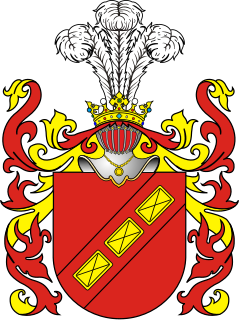
Dryja is a Polish coat of arms. It was used by several szlachta families in the times of the Polish-Lithuanian Commonwealth.

Kryszpin - is a Polish coat of arms. It was used by several szlachta families in the times of the Polish-Lithuanian Commonwealth.

Wczele - is a Polish coat of arms. It was used by several szlachta families in the times of the Polish-Lithuanian Commonwealth.
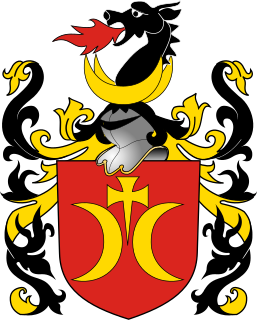
Ostoja is a Polish coat of arms that probably originated from Sarmatian Tamga and refer to Royal Sarmatians using Draco standard. Following the end of the Roman Empire, in the Middle Ages it was used by Ostoja family in Lesser Poland and later also in Kujavia, Mazowsze and Greater Poland. It is a coat of arms of noble families that fought in the same military unit using battle cry Hostoja or Ostoja, and that applied their ancient heritage on the Coat of Arms, forming a Clan of knights. Later, when the Clan expanded their territory to Pomerania, Prussia, Slovakia, Hungary and Romania they also adopted a few noble families of Ruthenian origin that in 14-15th century settled down in Lithuania, Belarus and Ukraine, finally turning into the Clan of Ostoja. As different lines of the clan formed surnames after their properties and adding the adoptions, Ostoja was also recognized as CoA of several families that was not necessary connected to the original Clan, forming Heraldic clan.
Finck is a surname or part of a longer surname of German origin and the name of several individuals:
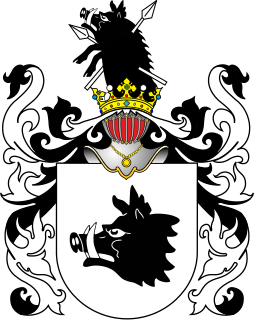
Denhof - is a Polish coat of arms. It was used by several szlachta families in the times of the Polish-Lithuanian Commonwealth. Dönhoff (German) or Denhoff (Polish) was a Livonian German noble family, a branch of which moved to the Polish-Lithuanian Commonwealth in the 16th century and became recognized as a Polish noble (szlachta) there.
Countess Katharina Dorothea Elisabeth Finck von Finckenstein was a member of the German noble family Finck von Finckenstein.
Finckenstein may refer to:

Finckenstein Palace was a baroque palace, designed by the architect John von Collas between 1716 and 1720 in the former West Prussia, about 25 mi. (40 km) south of Elbląg in present-day Poland. It was built by Prussian Field Marshal, Marquess, and Count Albrecht Konrad Reinhold Finck von Finckenstein and remained in the possession of the Finck von Finckenstein family until 1782. After that the Counts Dohna-Schlobitten lived in it until 1945. Red Army soldiers set the palace on fire January 22, 1945, during their conquest of East Prussia. The ruins are still visible.
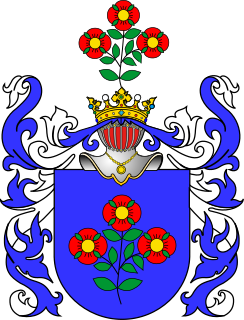
Antoniewicz, or Bołoz properly, is a Polish Coat of Arms from Armenian origin. It was used by Polish - Armenian szlachta familie Antoniewicz de (von) Bołoz, since ennoblement by emperor Josef II in 1789.

Finck von Finckenstein is a noble family classified as Uradel. It is one of the oldest Prussian aristocratic families extant, dating back to the 12th century in the Duchy of Carinthia.

Kotwicz is a Polish coat of arms. It was used by several szlachta families in the times of the Polish-Lithuanian Commonwealth.

Albrecht Konrad Reinhold Finck von Finckenstein was a Prussian nobleman, Field Marshal and statesman.

Finckenstein coat of arms - is a Coat of Arms used by the Finck von Finckenstein family.
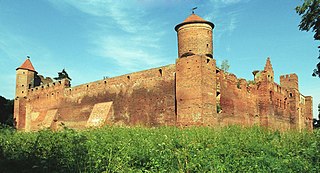
Szymbark is a village in the administrative district of Gmina Iława, within Iława County, Warmian-Masurian Voivodeship, in northern Poland. It lies approximately 8 kilometres (5 mi) north-west of Iława and 69 km (43 mi) west of the regional capital Olsztyn. The village has a population of 395.
Eva Gräfin Finck von Finckenstein, née Schubring was a German politician, representative of the German Christian Democratic Union.



















